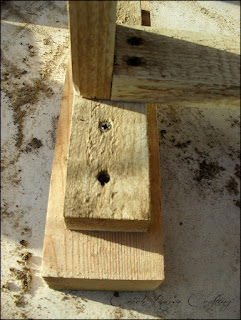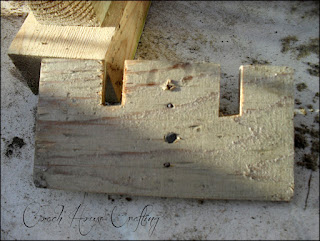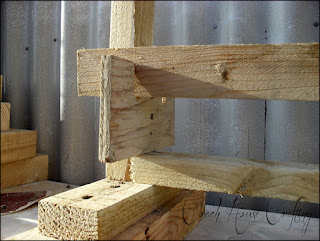Recycling old posts is not something I tend to do as the garden is forever changing but I felt there are certain projects that never age and hopefully this may solve the issue of space for a few people. The original photo of this project (included below) has done it's rounds on Pinterest but credit rarely goes back to the original source but I have no problems with people pinning and sharing this - enjoy!
Gardening here in the Scottish Highlands is unlike any kind of gardening I experienced at home in England and I initially made so many mistakes and lost so many plants due to my stubborness and naive determination to continue growing the plants I loved rather than discovering what would actually work here.
It was during those years of frustration that I sulked a tad where the gardening was concerned and turned my attention to building containers, obelisks and arbours from scrapwood - it kind of made me feel like I was achieving something despite having obliterated all my lovely plants. Plus containers meant I could move plants around according to the weather conditions.
That's the time I came up with this space saver idea. I needed something that would make use of height in my greenhouse and free up some space and at the same time it needed to be light enough to carry in and out as I needed.
This is the space saver:
It was really easy to make too with limited skills and tools and used only scrap wood and plastic milk cartons I saved. I made this one in half a day but it could take even less time if you organise your tools and materials beforehand which I don't tend to do!
So tools and materials needed:
- Scrap wood. Any scrap wood can be used and adapted but I used batten, 3"x2" and plyboard.
- Wood to use as the milk container supports - I used 1.5"x 1/4" beading.
- Screws and/or nails.
- Hand saw or electric cutter.
- Tape measure (always handy but I hardly ever use them)
- Stain for protecting. I used Cuprinol garden shades Natural Stone.
- Plastic milk cartons. I used 30 on mine but you can make the frame and add the cartons as you collect them.
The first stage is to make a rectangle frame using battens (or your chosen wood) and then add corner supports to the top of the frame only. (I didn't have any particular size of frame in mind I simply made it up as I went along - that's how I roll).
Once we have the frame done we need to attach some feet to support it. I used batten and 3"x2" for mine.
Once the batten is cut screw or nail it to the bottom of the frame like this:
Once those are attached to each side of the base end stand the frame up and cut 2 more pieces slightly larger from 3x2, or whatever wood you have. These are then screwed or nailed to the existing feet from the top down like this:
You can also see from the above photo that I then screwed the rectangle frame down into the first foot that was attached, this is just for extra stability.
Next we need to make some supports for the lengths of wood that will hold the milk containers.
I used plyboard for this as it was all I had suitable that was lying around. I basically cut 6 rectangles (3 for each side) and each rectangle had 2 grooves cut out of it from the top of the longer side to roughly half way through. These cuts need to be a suitable depth to hold whatever wood you are using for the container supports like this:
Once all the rectangles are cut and grooved they simply need attaching to the sides of the frame - I just spaced mine at equalish distances.
Once this is a completed it's just a simple case of cutting 6 lengths of wood for the container supports (I used thin beading) making sure the lengths are cut long enough to extend further than the supports at each end.
Finally give it all a coat of protective paint and start filling it with your pots by simply sliding the container supports through the handles of your milk containers.
This space saver is ideal for veggie seedlings being hardened off because you simply lift it and place it outside in the morning and then bring it back in at night, there's no bending and schlepping around with plastic pot holders that always tend to split and crumble right when you don't need them to.
It's also fabulous for rooted flower cuttings that need similar hardening off treatment and if you use the containers for herbs it can be easily placed against a warm wall right near the house.
OR if you're a crafter like myself it would be fabulous for holding crafting goodies such as pens, paints, ribbons, stamps etc etc.
Pretty versatile huh!
Now lets talk about those milk containers and how you can use pretty much all of the container as useful garden helpers.
First off take one of the plastic milk caontainers you've collected - all sizes are good but I personally would find the 2 pinters too small for this project but the bigger the container the bigger size pot it will hold. I used 4 pinters and 6 pinters.
OK so we need to pierce the side of the container with scissors (leave the lid on to keep the air in otherwise the container will simply collapse) and then cut right round the container so you get this:
The top part with the lid is all finished and ready for your newly built space saver.
Personally I try to leave the lids on the containers that will go on the top 2 layers of the space saver to stop any water draining into the layer below. The bottom layer of the space saver doesn't matter so much.
Now we're left with the bottom half of the container we cut so take your scissors and cut down the length of the container stopping where you see the next rigid line that goes all the way round the container. Turn at this point and cut round the circumference once again until it seperates from the bottom of the container, then take this middle section and cut straight down the middle of it to produce this:
Now all you need to do is use the middle section to cut strips off at whatever width you would like your plant labels to be. Once you've done this you then cut points onto one end of the cut strips and use the container base to store them.
See, the whole container has a use - yay!
Here you can see the strips before having the points cut and then the pot contains some where the points have been cut.
I hope this tutorial made sense to you all and that you can replicate it in some way for your home and garden, I would love to hear from anyone that has made it for themselves.














2 comments:
Very easiy and great reuse of materials.
Late to the party but came across this and its perfect for what I want, so wanted to thank you for a fantastic creation! Just collecting my milk cartons and this will become our new herb planter.
Post a Comment